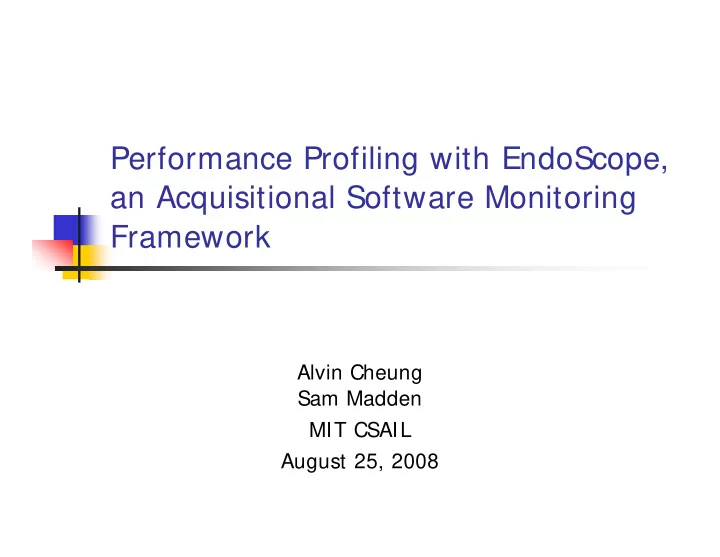

Performance Profiling with EndoScope, an Acquisitional Software Monitoring Framework Alvin Cheung Sam Madden MIT CSAIL August 25, 2008
Collecting System Runtime Data Many uses Real-time system monitoring Detect security breaches Dynamic recompilation However, collecting such information is often difficult 2
Example: Software Profiling Sampling / statistical profilers Gprof, oprofile Might not be accurate Can only be used to collect certain types of statistics Augment source code / Binary instrumentation ATOM, valgrind, dtrace Tedious work Create substantial overhead Want: a unifying infrastructure that can be used to collect and reason about program’s runtime data that is easy to use and introduces low overhead 3
Our Contributions Easy to use interface Use declarative queries Uniform data model that represents all sorts of runtime data Model them using the streaming data model Small footprint / overhead Be acquisitional: queries drive what data is collected you only pay to collect data you asked for Decouple program running site and monitoring site Use both sampling and instrumentation techniques Query evaluation tricks 4
Outline Data Model Query Evaluation Techniques Experiments Conclusions 5
Program Runtime Data as Streams EndoScope provides a number of basic streams that represent data coming from the runtime environment function start (function name, time) variable value (name, value, time) cpu usage (% busy, % idle, time) … Users can define additional streams on top of basic streams Streams are defined into two categories Enumerable streams are those that have discrete values in time (e.g., function start stream) Non-enumerable streams are those that have infinite values in time (e.g., CPU usage stream) Non-enumerable streams need to be quantified before they can be used (e.g., in an iterator) 6
Operations on Streams Quantify Sample non-enumerable streams at points in time Select Project Aggregate Window-based join 7
Conditions / Triggers Specify actions to be performed when certain event occurs Action examples: Start monitor CPU / heap usages Generate report to user Update machine learning models 8
Query Examples when select avg(f1.duration) > 5 sec and avg(f2.duration) > 5 sec from function_duration f1, f2 where f1.function_name = “foo” and f2.function_name = “bar” then sample cpu_load every 1 min select * from function_start fs, cpu_load cl where fs.function_name = “foo” and cl.busy > 70% 9
Outline Data Model Query Evaluation Techniques Experiments Conclusions 10
Architecture instrumentation plan Stream Stream Query Plan query results tuples Processing Processing Optimizer Engine Engine Code query plan Instrumentor query plan User collected Query data Plan instrumentation instructions query Query Profiled Plan Program Optimizer Remote Monitoring Site Program Execution Site 11
Optimizing Query Execution Goal: introduce as little runtime overhead as possible while providing reasonable query execution performance Three levels of optimization Execution site Query plan Stream implementation 12
Execution Site Selection Query plan can be executed on program running site or remote monitoring site Aspects to consider cpu bound vs. network bound Amount of data needed to be sent Number of monitoring sites System conditions change over time! Change query plans adaptively (future work) 13
Query Plan Optimization select * from function_start fs, cpu_load cl where fs.function_name = “foo” and cl.busy > 70% Join evaluation strategy 1: Monitor all “foo” call sites and cpu usage at all times Join evaluation strategy 2: Instrument all “foo” call sites Every time when “foo” is called, sample cpu usage, check if > 70% Join evaluation strategy 3: Do not instrument “foo” Continuously sample cpu usage If sampled usage is > 70%, then instrument “foo” call sites 14
Query Plan Optimization (2) Need cost model Simple cost model: Extra instructions Frequency from data collecting x of such operations operations Challenge Frequency estimates changes over program lifetime! Change query plans adaptively (future work) 15
Optimizing Stream Implementation Implementing function start stream Exact Instrument all call sites Use code analysis to reduce # functions to instrument Approximate Sample stack trace and check if function is called Need cost model, and understand how much approximation user can tolerate 16
Outline Data Model Query Evaluation Techniques Experiments Conclusions 17
Experiments Setup Implemented a simple profiler for Java programs on top of EndoScope Monitored performance of 3 apps SimpleApp included with Apache Derby TPC-C implementation using Derby Petstore app hosted on Tomcat that uses Derby Measured runtime overhead 18
Runtime Overhead Experiment Rank all functions by their call frequencies over program run Issue query to system Progressively increase the % of functions monitored, with the least frequently called function chosen first Compare time overhead with other profilers 19
20
25-50% less overhead when compared to other profilers 21
Join Operator Ordering Expt Query on top of TPC-C implementation SELECT * FROM function_start fs, cpu_load cl WHERE fs.function_name in (f1,f2..) AND cl.busy > 70% Quantify the effects of operators ordering by measuring the time overhead of 3 different query plans 22
Less overhead when # functions monitored is small Less overhead with continuous CPU monitoring 23
Outline Data Model Query Evaluation Techniques Experiments Conclusions 24
Contributions Introduced a low overhead, query driven, acquisitional software monitoring framework Proposed data model, a declarative query language, and query evaluation techniques Implemented a simple profiler for Java programs and validated on real-world systems 25
Recommend
More recommend